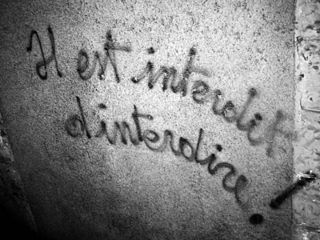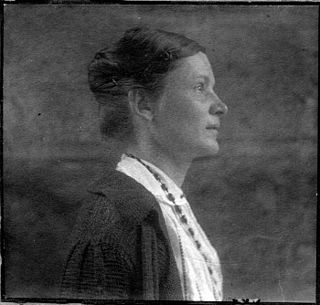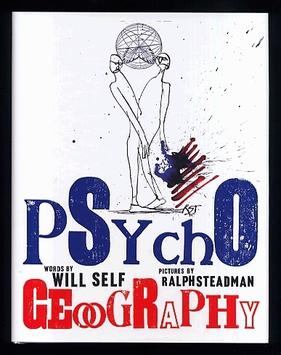Related Research Articles

Gentrification is the process of changing the character of a neighborhood through the influx of more affluent residents and investment. There is no agreed-upon definition of gentrification. In public discourse, it has been used to describe a wide array of phenomena, usually in a pejorative connotation.

The Situationist International (SI) was an international organization of social revolutionaries made up of avant-garde artists, intellectuals, and political theorists. It was prominent in Europe from its formation in 1957 to its dissolution in 1972. The intellectual foundations of the Situationist International were derived primarily from libertarian Marxism and the avant-garde art movements of the early 20th century, particularly Dada and Surrealism. Overall, situationist theory represented an attempt to synthesize this diverse field of theoretical disciplines into a modern and comprehensive critique of mid-20th century advanced capitalism.

The Letterist International (LI) was a Paris-based collective of radical artists and cultural theorists between 1952 and 1957. It was created by Guy Debord and Gil J. Wolman rejoined by Jean-Louis Brau and Serge Berna as a schism from Isidore Isou's Lettrist group. The group went on to join others in forming the Situationist International, taking some key techniques and ideas with it.

Psychogeography is the exploration of urban environments that emphasizes interpersonal connections to places and arbitrary routes. It was developed by members of the Letterist International and Situationist International, which were revolutionary groups influenced by Marxist and anarchist theory as well as the attitudes and methods of Dadaists and Surrealists.

The London Psychogeographical Association (LPA), sometimes referred to as the London Psychogeographical Committee, is an organisation devoted to psychogeography. The LPA is perhaps best understood in the context of psychogeographical praxis.
Psy-Geo-Conflux is an annual New York City festival dedicated to psychogeography, where visual, performance and sound artists, writers, urban adventurers, researchers and the public gather for four days to explore the physical and psychological landscape of the city.

Constant Anton Nieuwenhuys, better known as Constant, was a Dutch painter, sculptor, graphic artist, author and musician.

The dérive is an unplanned journey through a landscape, usually urban, in which participants stop focusing on their everyday relations to their social environment. Developed by members of the Letterist International, it was first publicly theorized in Guy Debord's "Theory of the Dérive" (1956). Debord defines the dérive as "a mode of experimental behaviour linked to the conditions of urban society: a technique of rapid passage through varied ambiances."

Michèle Bernstein is a French novelist and critic, most often remembered as a member of the Situationist International from its foundation in 1957 until 1967, and as the first wife of its most prominent member, Guy Debord.
Lizzie Mary Cullen is a British artist situated in London.

Sophie Suzanne Brzeska or Sophie Gaudier-Brzeska was a Polish writer and artistic muse most noted for being the companion of the artist Henri Gaudier-Brzeska.
Riot grrrl is an underground feminist punk movement that began during the early 1990s within the United States in Olympia, Washington and the greater Pacific Northwest and has expanded to at least 26 other countries. A subcultural movement that combines feminism, punk music, and politics, it is often associated with third-wave feminism, which is sometimes seen as having grown out of the riot grrrl movement and has recently been seen in fourth-wave feminist punk music that rose in the 2010s. The genre has also been described as coming out of indie rock, with the punk scene serving as an inspiration for a movement in which women could express anger, rage, and frustration, emotions considered socially acceptable for male songwriters but less commonly for women.
Laura Owens is an American painter, gallery owner and educator. She emerged in the late 1990s from the Los Angeles art scene. She is known for large-scale paintings that combine a variety of art historical references and painterly techniques. She lives and works in Los Angeles, California.

Psychogeography is a 2007 book written by Will Self and illustrated by Ralph Steadman.

The Golden Fleet was a minor left-wing group in Sweden, existing during the end of the 1960s and the beginning of the 1970s. It was ideologically aligned with the Situationist International, an avant-garde revolutionary movement. The Situationists, whose intellectual foundations were derived primarily from libertarian Marxism and the avant-garde art movements of the early 20th century, initially put its emphasis on concepts like unitary urbanism and psychogeography. Gradually the focus moved more towards revolutionary and political theory. Much like the main organ of that particular ideological current, the Situationist International, the Golden Fleet had its heyday around the protests of 1968, gradually disappearing by the first years of the 1970s.
Wrights & Sites is a group of British artists who work with site-specific performance and walking art. Founded in 1997, Wrights & Sites consists of artist researchers Stephen Hodge, Simon Persighetti, Phil Smith and Cathy Turner. Their work is inspired by the Letterist and Situationist Internationals, particularly the practice of dérive.
Walkwalkwalk (2005–2010) is a British artist collective consisting of Gail Burton, Serena Korda and Clare Qualmann. Based in London, their work focused on routine walks in the Bethnal Green neighborhood of East London, as well as overlooked and forgotten spaces. Through their work they looked to create a new "'archaeology of the familiar and the forgotten' in London's East End".:50 Scholars have discussed walkwalkwalk's works in a variety of contexts, including psychogeography, walking as an artistic medium, Live Art, and criminology.
The Loiterers Resistance Movement (2006–present) is a 'Manchester-based collective of artists and activists interested in psychogeography and public space.' The Loiterers Resistance Movement (LRM) are core contributors to what Tina Richardson has identified as the 'new psychogeography', and a variety of scholars have cited the LRM as key to the development of contemporary British psychogeography.

Hauntology is a music genre or a loosely defined stylistic feature that evokes cultural memory and aesthetics of the past. It developed in the 2000s primarily among British electronic musicians, and typically draws on British cultural sources from the 1940s to the 1970s, including library music, film and TV soundtracks, psychedelia, and public information films, often through the use of sampling.
Walking art refers to a variety of artistic practices that position walking as the central process, experience or outcome. Walking artists have diverse interests and it 'has gathered practitioners from nearly every field'.:43 Despite emerging from a variety of artistic and literary traditions, a 'common feature [of walking art] is the engagement of the body in a process of walking through a landscape based on a specific artistic design.':161 Some artists consider walking an artistic end in itself, while others use walking as a means of mark-making, storytelling, social practice, or to create work in other artistic media.
References
- 1 2 3 4 5 6 7 8 9 McLaughlin, Rosanna (9 February 2017). "Laura Oldfield Ford: 'I map ruptures, such as the London riots'". Studio International . Retrieved 4 July 2018.
- 1 2 3 Jacques, Juliet (8 October 2019). "Mapping a Gentrifying London with Laura Grace Ford's 'Savage Messiah'". Frieze . Retrieved 21 May 2020.
- 1 2 3 4 5 6 Sherwin, Skye (18 February 2011). "Artist of the week 126: Laura Oldfield Ford". The Guardian . Retrieved 11 June 2011.
- 1 2 3 Poynor, Rick (Winter 2012). "Regeneration X". Eye . Retrieved 30 April 2015.
- 1 2 3 Gravett, Paul (4 October 2009). "Laura Oldfield Ford: Savage Messiah" . Retrieved 13 July 2013.
- 1 2 3 4 Dakin, Melanie (25 November 2009). "Artist Laura Oldfield Ford examines the legacy of new towns in Hatfield". Watford Observer . Retrieved 24 August 2011.
- ↑ Reynolds, Nigel (15 June 2007). "Conceptualism 'runs out of puff'". The Daily Telegraph . Retrieved 13 July 2013.
- ↑ "Fanzines – The scene that smells of zine spirit". The Independent . 25 September 2009. Retrieved 13 July 2013.
- 1 2 3 Sandhu, Sukhdev (January–February 2013). "Avant-Pulp Psychogeography". American Book Review. 34 (2): 6–7. doi:10.1353/abr.2013.0026. S2CID 144860758.
- 1 2 3 Dixon, James R. (26 April 2013). "Two Riots: The Importance of Civil Unrest in Contemporary Archaeology (draft)". Academia.edu.
- ↑ Adams, Tim; Ahmed, Fatema; Alton, Roger; Anam, Tahmima; Aspden, Rachel; Bayley, Stephen; Bhutto, Fatima; Bright, Martin; et al. (13 November 2008). "Books of the year 2008". New Statesman . Retrieved 13 July 2013.
- 1 2 Sinclair, Iain (22 December 2011). "Savage Messiah by Laura Oldfield Ford – review". The Guardian . Retrieved 30 April 2015.
- ↑ Kunzru, Hari (17 November 2011). "Books of the year 2011: Hari Kunzru". New Statesman . Retrieved 13 July 2013.
- ↑ Marcus, Greil (2015). Real Life Rock: The Complete Top Ten Columns, 1986–2014. Yale University Press. p. 471. ISBN 9780300218596.
- ↑ Marcus 2015, p. 472.
- ↑ Taylor, J. D. (2013). Negative Capitalism: Cynicism in the Neoliberal Era. Zero Books. p. 92.
- ↑ Taylor 2013, pp. 118–9.
- ↑ Taylor 2013, p. 125.
- ↑ Davies, Dominic (2017). "'Comics on the Main Street of Culture': Alan Moore and Eddie Campbell's From Hell (1999), Laura Oldfield Ford's Savage Messiah (2011) and the politics of gentrification" (PDF). Journal of Urban Cultural Studies. 4 (3): 345. doi:10.1386/jucs.4.3.333_1.
- ↑ Davies 2017, pp. 347–8.
- ↑ Davies 2017, p. 351.
- 1 2 3 Fisher, Mark (17 February 2009). "Laura Oldfield Ford". Frieze . Retrieved 11 June 2011.
- 1 2 Davies, Anna (6 June 2009). "The Effluent Society". Hackney Citizen. Retrieved 13 July 2013.
- ↑ "There is a Place – Exhibition @newartgallery until 14.4.12". Area Culture Guide. 7 February 2012. Retrieved 28 April 2015.
- ↑ "Desire Lines". This Is Tomorrow. 9 December 2012. Retrieved 28 April 2015.
- ↑ Wright, Georgina (18 February 2014). "Review: Soft Estate – Edward Chell, The Bluecoat, Liverpool". Corridor8. Retrieved 28 April 2015.
- ↑ Pilger, Zoe (9 March 2014). "Ruin Lust at Tate Britain, art review". The Independent . Retrieved 28 April 2015.
- ↑ Gregory, Hannah (21 November 2014). "Seroxat, Smirnoff, THC: Laura Oldfield Ford". Icon. Retrieved 28 April 2015.
- ↑ Wade, Cathy (30 July 2016). "Living City Plan: Laura Oldfield Ford At Grand Union, Birmingham". The Quietus . Retrieved 21 May 2020.
- ↑ Barry, Robert (19 February 2017). "Zones Of Sacrifice: Drifting Through London With Laura Oldfield Ford". The Quietus . Retrieved 21 May 2020.
- ↑ Hatherley, Owen (2 March 2017). "Architects and designers are no good at altering your mental topography". Dezeen . Retrieved 21 May 2020.
- ↑ Barry, Robert (10 December 2022). "Afraid Of The Dark: Horror At Somerset House". The Quietus . Retrieved 19 December 2022.
- ↑ Collier, Christopher (2017). "'Our Monuments Shall Be the Maws of Kites': Laura Oldfield Ford and the Ghosts of Psychogeography Past". In Lee, Christina (ed.). Spectral Spaces and Hauntings: The Affects of Absence. Routledge. p. 171.
- 1 2 Slater, Josephine Berry; Iles, Anthony (25 November 2009). "Interview with Laura Oldfield Ford". Mute . Retrieved 30 April 2015.
- ↑ Harris, Andrew (April 2012). "Art and gentrification: pursuing the urban pastoral in Hoxton, London" (PDF). Transactions of the Institute of British Geographers . 37 (2): 226–241. Bibcode:2012TrIBG..37..226H. doi:10.1111/j.1475-5661.2011.00465.x.
- 1 2 Collier 2017, p. 165.
- ↑ Collier 2017, p. 172.
- ↑ Collier 2017, p. 176.
- ↑ Pinder, David (2018). "Transforming Cities: On the Passage of Situationist Dérive". Performance Research . 23 (7): 25. doi:10.1080/13528165.2018.1554849. S2CID 194241593.
- ↑ Cummins, Emma (2013). "Perspectives and contingencies". City: Analysis of Urban Trends, Culture, Theory, Policy, Action. 17 (3): 414–418. Bibcode:2013City...17..414C. doi:10.1080/13604813.2013.798885. S2CID 143776229.